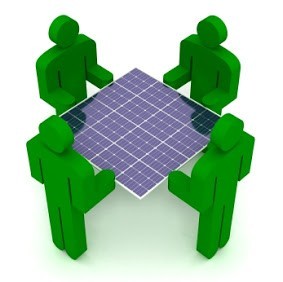
Photonics offers high-tech solutions for a wide array of application areas that can materially contribute to sustainability thanks to their features, potential uses and modes of operation. Here are three examples presented to illustrate the vast potential and diversity of these key technologies. These applications have contributed significantly to climate protection in the past, yet still harbor enormous potential, such as photovoltaics, LEDs and in today's data centers.
Even in technology areas where photonics have already proven their sustainability, and where the market environment sees mature products and a market saturation, more efficient new solutions are ready to be deployed. One example is LED televisions and their potential successors, OLED and quantum dot displays.
Co2 avoidance through photovoltaics
The realization that climate protection targets cannot be reached without scaling up the proportion of renewable energies has now registered with people. The simplest solar technology is solar thermal technology in which solar energy is converted and heat is collected. However, the most promising technology is photovoltaics, which generates electricity from sunlight.

The widespread use of this technology over the last decade has led to a gradual reduction in investment and operating costs. The International Agency for Renewable Energies therefore, expects that photovoltaics will be able to compete with fossil energy sources everywhere from 2020. Not only for this reason, it is expected that its share in the global energy mix will continue to grow very strongly in future years. Countries around the world are relying on the massive expansion of photovoltaics. According to calculations by the International Energy Agency (IEA), in 2040 more than 17 percent of electricity generated globally will come from photovoltaics.
The effects on climate protection are significant: Even today, according to calculations by Tematys, the energy generated by photovoltaics corresponds to an equivalent annual saving of around 569 million tons of CO2. Given the continuing increase in the distribution of this technology, this effect – assuming sustainable policies (Sustainable Policies Scenario) – will nearly quadruple by 2030, which will correspond to an annual avoidance of 2,130 million, or 2.13 billion tons CO2eq. The degree of efficiency of photovoltaics in relation to energy generation and storage is increasing continuously, which promotes this development. A further major benefit of photovoltaics is that its production is virtually carbon neutral. Several comprehensive studies of the lifecycle of photovoltaics plants have shown that their emissions factor is between 0.020 and 0.050 t CO2eq/MWh.
C02 avoidance through energy-efficient lighting
Lighting accounts for around 15% of global energy consumption. The climate protection effect that is already achieved and expected through the use of energy efficient lamps is high.
In the 1990s, the light sources installed mainly consisted of light bulbs and fluorescent tubes. In 2008, the European Union (EU) decided to phase out traditional light bulbs, with similar laws passed in many other countries. Even though the light capacity that was installed continued to increase, the use of energy savings lamps had already started to have an effect. After a peak in 2010, the energy consumption for lighting in the EU fell by more than 5% by 2013.

We are now living through an “LED revolution” with a vastly increased efficiency of LEDs compared to regular light bulbs, resulting in significant energy savings and, through that, a significant reduction in greenhouse gas emissions. Based on the global energy consumption for the lighting of 4,050 TWh in 2012, it is assumed that savings of 25% will already be achieved in 2019 (3,000 TWh) and savings of 50% will be achieved by 2030 (2,000 TWh). Following this, energy consumption will initially stabilize, since by then a large proportion of the installed lamps and modules will be LEDs. However, research is already underway into technologies which are even more efficient than LEDs.
Even though the volume of light will increase slightly, it is expected that the growing distribution of LED technology in 2030 will result in the avoidance of 503 million tons of CO2eq per year. This development is also favored by the continued increase in the efficiency of LEDs and the fact that smart lighting systems can optimize their use.
CO2 avoidance in data centers
In the age of communication and digitization, the required processing power is continuously rising. While the data processed by data centers in 2010 was still 1 exabyte (1 EB =1 million terabytes), an increase to 220 zettabytes is expected (1 ZB = 1 billion terabytes) by 2030. Assuming a global energy consumption of 180 TWh for 4 ZB in 2014, the energy consumption of data centers would therefore reach 9,900 TWh in 2030.

In 2014, the energy consumption of data centers was distributed as follows: More than 40 percent is accounted for by the general infrastructure, less than 10% to lighting and devices used to ensure uninterrupted power supply (UPS) and around 50 percent to the so-called IT infrastructure, which includes CPUs, memories and the IT network. But these figures are changing. Data center providers use several approaches to counteract a possible drastic increase in greenhouse gas emissions. Electricity is obtained from renewable energies such as photovoltaics. They aim to improve the Power Usage Effectiveness (PUE) value. This compares the total energy consumed by a data center (e.g., for cooling) to the energy consumed by the IT infrastructure. Corresponding measures promise a large leverage effect, and it is assumed that energy consumption in 2030 will be below 700 TWh instead of the 9,900 TWh projected above.
In addition, a reduction in watt hours (Wh) per byte in the IT network, i.e. in the data centers’ mobile and cable networks, is being aimed for. Optical data transmission plays an important role here. Significant effects have already resulted from the substitution of copper with optical connections. This development is practically complete. Efforts to further improve the Wh-byte ratio, such as by using silicon photonics and other optical innovations, particularly in electronic circuits, can result in an annual energy saving of more than 4 KWh in 2030.
Written by Tematys and is an excerpt from “Light as the key to global environment sustainability: High-tech photonics solutions to protect the environment and preserve resources”, a new study by Spectaris, the Fraunhofer Institute, Tematys and Messe Munchen































 Back to Blog
Back to Blog

























